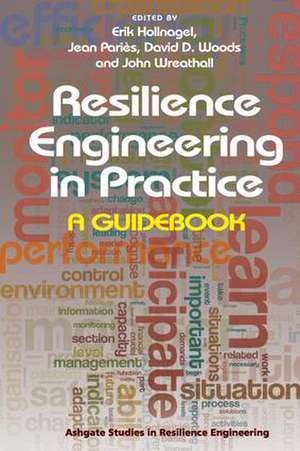Resilience Engineering in Practice: A Guidebook: Ashgate Studies in Resilience Engineering
Autor Jean Pariès Editat de Erik Hollnagel Autor John Wreathallen Limba Engleză Hardback – 23 dec 2010
| Toate formatele și edițiile | Preț | Express |
|---|---|---|
| Paperback (1) | 391.08 lei 3-5 săpt. | +22.99 lei 4-10 zile |
| CRC Press – noi 2013 | 391.08 lei 3-5 săpt. | +22.99 lei 4-10 zile |
| Hardback (1) | 1121.81 lei 6-8 săpt. | |
| CRC Press – 23 dec 2010 | 1121.81 lei 6-8 săpt. |
Preț: 1121.81 lei
Preț vechi: 1368.06 lei
-18% Nou
Puncte Express: 1683
Preț estimativ în valută:
214.73€ • 233.32$ • 180.49£
214.73€ • 233.32$ • 180.49£
Carte tipărită la comandă
Livrare economică 21 aprilie-05 mai
Preluare comenzi: 021 569.72.76
Specificații
ISBN-13: 9781409410355
ISBN-10: 1409410358
Pagini: 362
Ilustrații: includes c. 34 figures & c. 23 tables
Dimensiuni: 156 x 234 x 21 mm
Greutate: 0.82 kg
Ediția:New ed
Editura: CRC Press
Colecția CRC Press
Seria Ashgate Studies in Resilience Engineering
ISBN-10: 1409410358
Pagini: 362
Ilustrații: includes c. 34 figures & c. 23 tables
Dimensiuni: 156 x 234 x 21 mm
Greutate: 0.82 kg
Ediția:New ed
Editura: CRC Press
Colecția CRC Press
Seria Ashgate Studies in Resilience Engineering
Cuprins
Contents: Prologue: the scope of resilience engineering, Erik Hollnagel; Part I Dealing with the Actual: Resilience and the ability to respond, Jean Pariès; Lessons from the Hudson, Jean Pariès; Coping with uncertainty. Resilient decisions in anaesthesia, Lucie Cuvelier and Pierre Falzon; Training organisational resilience in escalating situations, Johan Bergström, Nicklas Dahlström, Sidney Dekker and Kurt Petersen. Part II Dealing with the Critical: Monitoring - a critical ability in resilience engineering, John Wreathall; From flight time limitations to fatigue risk management systems - a way toward resilience, P. Cabon, S. Deharvengt, I. Berechet, J.Y. Grau, N. Maille and R. Mollard; Practices for noticing and dealing with the critical. A case study from maintenance of power plants, Elizabeth Lay; Cognitive strategies in emergency and abnormal situations training - implications for resilience in air traffic control, Stathis Malakis and Tom Kontogiannis. Part III Dealing with the Potential: Resilience and the ability to anticipate, David D. Woods; Basic patterns in how adaptive systems fail, David D. Woods and Matthieu Branlat; Measuring resilience in the planning of rail engineering work, P. Ferreira, J. R. Wilson, B. Ryan and S. Sharples; The art of balance: using upward resilience traits to deal with conflicting goals, Berit Tjørhom and Karina Aase; The importance of functional interdependencies in financial services systems, Gunilla A. Sundström and Erik Hollnagel. Part IV Dealing with the Factual: To learn or not to learn, that is the question, Erik Hollnagel; No facts, no glory, John Stoop; From myopic coordination to resilience in socio-technical systems. A case study in a hospital, Anne Sophie Nyssen; Requisites for successful incident reporting in resilient organisations, Alberto Pasquini, Simone Pozzi, Luca Save and Mark-Alexander Sujan; Is the aviation industry ready for resilience? Mapping human factors assumptions across the aviation sector, Kyl
Notă biografică
Erik Hollnagel (Ph.D., psychology) is Professor and Industrial Safety Chair at École des Mines de Paris (France), Professor Emeritus at University of Linköping (Sweden), and Visiting Professor at the Norwegian University of Science and Technology (NTNU) in Trondheim (Norway). He has since 1971 worked at universities, research centres, and industries in several countries and with problems from several domains, including nuclear power generation, aerospace and aviation, air traffic management, software engineering, healthcare, and land-based traffic. His professional interests include industrial safety, resilience engineering, accident investigation, cognitive systems engineering and cognitive ergonomics. He has published more than 250 papers and authored or edited 17 books, some of the most recent titles being The ETTO Principle (Ashgate, 2009), Resilience Engineering Perspectives: Preparation and Restoration (Ashgate, 2009), Resilience Engineering Perspectives: Remaining Sensitive to the Possibility of Failure (Ashgate, 2008), Resilience Engineering: Concepts and Precepts (Ashgate, 2006), and Barriers and Accident Prevention (Ashgate, 2004). Erik Hollnagel is Editor-in-chief of Ashgate Studies in Resilience Engineering and, together with Pietro C. Cacciabue, Editor-in-Chief of the International Journal of Cognition, Technology & Work. Jean Pariès graduated from the French National School of Civil Aviation as an engineer, then joined the DGAC for several positions dealing with air safety regulations. He was a member of the ICAO Human Factors & Flight Safety Study Group since its creation in 1988. In 1990, he joined the Bureau Enquêtes Accident as Deputy Head, and Head of Investigations, where he led the technical investigation into the Mont Saint-Odile air accident, 1992. In 1994, Jean left the BEA to be a founding member - and now the CEO - of Dédale SA. Set in Paris and Melbourne (Australia), Dédale activity focuses on the Human and Organisational dimensions
Recenzii
'Although risk management has brought greater safety to socio-technical systems, a new approach is still strongly needed. Erik Hollnagel's excellent book offers the right approach; that resilient behaviour by people leads to stable systems. Those searching for a more profound understanding of system safety must read this book as it is a practical guide to this new approach.' Akinori Komatsubara, Waseda University, Japan 'With crises abounding, the concept of resilience is more relevant than ever. Manifold examples from a variety of high-risk industries provide insights into the four basic requirements for resilience: responding, monitoring, anticipating, and learning. Tools are presented that support the assessment of these requirements as well as their promotion, be it by training emergency management, handling fatigue of system operators, supporting preventive maintenance, providing better rules for managing conflicting goals, or improving incident reporting. The book, by Erik Hollnagel and his colleagues, will be a great resource for system designers and decision-makers in organizations in their endeavours to keep the uncertainties and complexities of our world at bay.' Gudela Grote, ETH Zürich, Switzerland 'Be prepared to be unprepared. How do you do that? By absorbing the evocative data, nuanced terminology, sustained guidance, and broad applications summarized here. Resilience is about more than engineering as becomes clear in these descriptions of the actual, critical, potential, and factual events that unfold when disturbances fall outside the operational envelope. Resilience engineering is a hot topic. Here is the one book that shows you why!' Karl E. Weick, University of Michigan, USA 'The book is very practical in the sense that only relevant and significant theories or frameworks are discussed followed by extensive descriptions of the situations on the field. Solution-seekers are the group of readers who will benefit the most from readin
Descriere
Resilience engineering depends on four abilities: the ability a) to respond to what happens, b) to monitor critical developments, c) to anticipate future threats and opportunities, and d) to learn from past experience - successes as well as failures. They provide a structured way of analysing problems and proposing practical solutions. This book is divided into four sections which describe issues relating to each of the four abilities. The section's chapters emphasise practical ways of engineering resilience, featuring case studies and real applications.
























